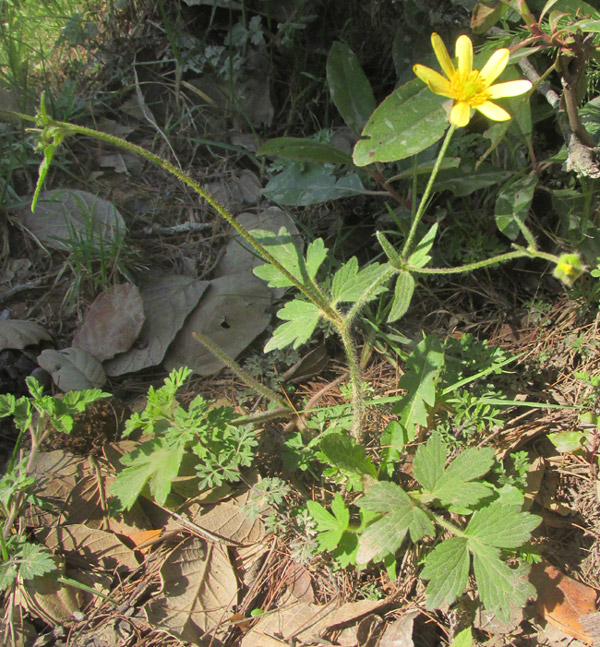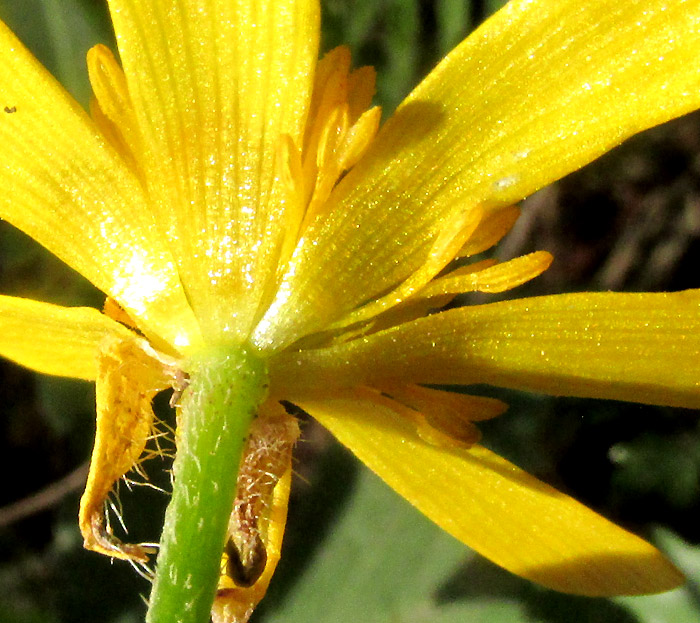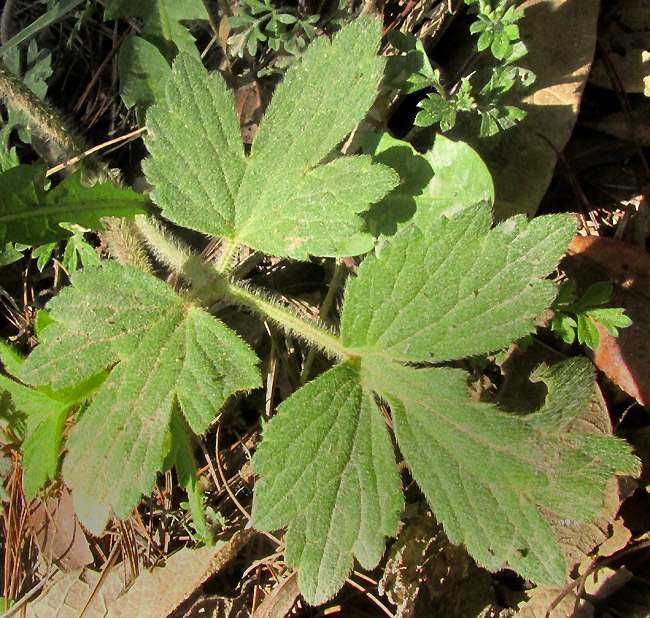Excerpts from Jim Conrad's
Naturalist Newsletter
Entry from field notes dated September 2, 2023, taken in Los Mármoles National Park in the Eastern Sierra Madre mountains, Hidalgo state, MÉXICO; along road leading to Puerto de Piedra, which branches off the road between Trancas {on maps designated "Morelos (Trancas)"} and Nicolás Flores; limestone bedrock; elevation ~2,550m (~8,400ft); ~N20.81°, ~W99.23°
RANUNCULUS FASCICULATUS

Among roadside weeds occasionally grazed by roving cattle, the above herb's fresh, yellow blossoms stood out in a landscape caught in an ongoing two-year drought. From a distance, I thought it looked like one of many small, yellow-flowered members of the enormous Composite/Aster/Daisy Family, but up close the blossom told a different story:

It's a single flower with eight petals, many stamens and several greenish-yellow pistils, not a composite head of many florets, as in the Aster Family. Northerners familiar with their local wildflowers and weeds might recognize this as a buttercup. Buttercups are species of the genus Ranunculus of the Buttercup Family, the Ranunculaceae.
An important field mark for buttercup flowers is that instead of the female part consisting of a single ovary with its style and stigma, the blossom's center is occupied by several to many distinct pistils, each pistil comprising an ovary, a style and a stigma. Each buttercup pistil matures into a one-seeded fruit.

If you need confirmation that you have a Ranunculus, look for a nectary scale near the base of each petal, as seen at the right. All buttercup species bear nectar-producing nectaries at their petal bases, and most cover their nectar with a scale. In the picture, the nectary scale is in the center, structured like a wall bowl.

In some buttercup species, beneath the corollas the sepals persist even after the petals and stamens have dropped off, and the pistils have matured into fruits. However, in the above picture only two wilted sepals remain on our plant, their lower surfaces bearing long hairs.

This species' leaves are compound, usually consisting of three deeply lobed leaflets. The leaflets' margins are toothed, and the center leaflet's stem, or petiolule, is considerably longer than those of the side leaflets. The petioles and petiolules are densely hirsute with long, erect, straight hairs.
More than 1700 currently-accepted buttercup species are known, mostly native to the Northern Hemisphere's temperate zones. Usually they're thought of as flowering in the spring, especially in moist, wet, or even aquatic environments, though some are summer-garden favorites, and others are roadside weeds. Many buttercup flowers are butter yellow, but others aren't. The 2021 work by José Luis Villaseñor and others entitled "Riqueza y distribución de la flora vascular del estado de Hidalgo, México" reports that here in upland central Mexico's Hidalgo state eleven Ranunculus species are documented.
In our part of highland central Mexico, if you have Ranunculus with compound leaves divided into three deeply lobed and toothed leaflets, and if the number of pistils in the flower, or one-seeded fruits in fruiting heads, is less than 30, you have one of a cluster of closely related and very similar taxa about which there's disagreement on how to name them.
When I use the 2015 treatment of the genus Ranunculus in the Flora del Bajío, our plant easily keys out to Ranunculus petiolaris variety arsenei. However, Kew's Plants of the World database currently considers that varietal name as a synonym of RANUNCULUS FASCICULATUS, and that's the name I'm using.
Though Ranunculus fasciculatus occurs in southern Arizona and western Texas, so far no commonly used English name has arisen for it. Mainly it's a Mexican species, commonly occurring in oak-pine forests and vegetation resulting from disturbances in those forests, throughout Mexico's uplands south to Morelos state south of Mexico City.
Several sources mention that our plant is medicinal, though none mentions for what, or how to use it. However, in general, buttercup species are regarded as somewhat or very toxic to herbivores; that may explain why our plant stood alone flowering on a cattle-grazed roadside. Toxic compounds often can be used medicinally. In fact, a survey of the literature published on the PubMed Central website, about the results of clinical analyses of various Ranunculus species, finds that the extracts of various species have demonstrated "... many activities, including antibacterial, antiviral, and antiprotozoal effects, as well as antioxidant and anticarcinogenic properties."